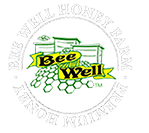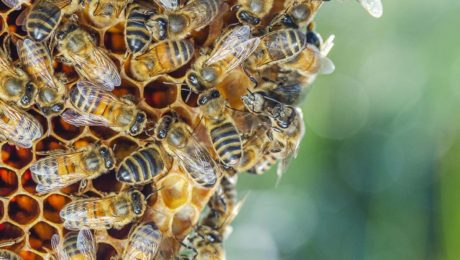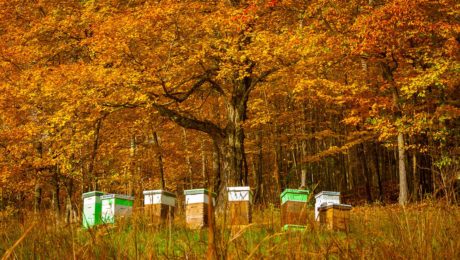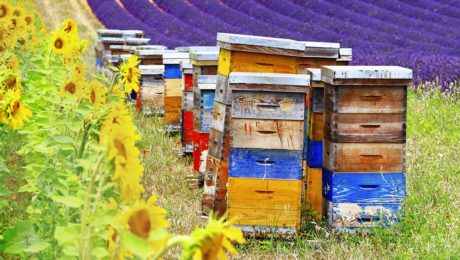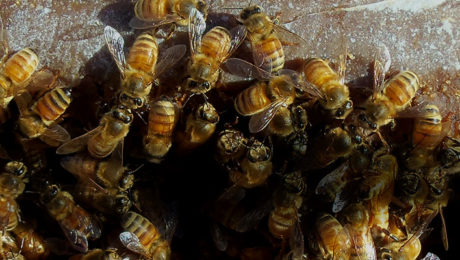Bee Well Honey is The Premium Nationwide Supplier for Quality Beekeeping Supplies. Order beekeeping supplies online or in-store.
The bad news: Bee habitat is on the decline, and honeybee populations are crashing. The good news: a small garden gesture can have a very positive impact! How can one person help increase the bee population and diversity? Easy! By simply providing a consistent source of pollen and nectar and creating a safe habitat, you can instantly create a safe haven for the entire life cycle of our pollinating friends. In return, the bees will not only amplify your garden’s fruit and veggie yield but will also provide you with nature’s most delicious, healthy food: honey!
What to plant
Choose a variety of flowers that have staggered bloom periods throughout the year, ensuring a steady food supply for the bees. The USDA plant hardiness zone map can help you choose optimal plants, both for survival and for bloom time. Native plants will not only foster native bee communities, but will also promote habitat for other native insects, birds, and wildlife. Native plants will also help to strengthen the natural enemies of your plants and their pests, protecting both the bees and your garden. Local plant nurseries will be able to help you select native plants. To attract bees, it is best to avoid hybridized plants. While attractive to us, hybridized plants have been bred not to seed, so their pollen is scarce.
Diversify
Bees love purple, blue, violet, yellow, and white. Plant flowers of a single species in clusters of about four-foot diameter, to help catch the eyes of the bees. A variety of flower shapes will attract a diversity of bees, though single flower tops, such as marigolds or daisies, produce more nectar than do double flower topped plants.
What to avoid
Herbicides and pesticides have many unintended consequences. Chief among them is the unintentional killing of the “good bugs”. With an eye toward soil (and subsequent plant) health, you will foster communities of natural predators, such as ladybugs, praying mantises, and spiders. The bonus, of course, is better health for kids, pets, and ourselves, as we venture forth into our gardens!
Providing shelter
Native bees need safe places to nest. While wood-nesting bees may take up residence in a beetle tunnel of a dead tree, a ground-nesting bee may excavate tunnels under bare ground. Bumble bees may nest in cavities, such as an abandoned rodent burrow. In lieu of setting aside a vacant piece of land for bees to inhabit, you could build a nesting block Alternatively, these portable nesting sites can be purchased at garden centers or backyard bird shops. Staking your box three to six feet above the ground is appropriate, with entrance holes facing southeast or east to capture the morning sun.
Estimated reading time: 2 minutes
A gaggle of geese, a herd of cows, a pack of wolves, a cluster of bees…. it’s all semantics.
Honeybee Cluster
What is the cluster size? This is a common question you may hear among beekeepers when discussing the size of a honey bee colony. The honeybee cluster is the main brood area of the hive. Here the queen will lay eggs and the nurse bees will feed the young. Honey and pollen will be stored nearby for ready access. The cluster area is the “heart of the hive”, especially in winter.
Most of the year, the honeybees will be spread out over the frames going  about their daily chores. But the arrival of cool weather forces the bees to begin the clustering behavior. Because of the rearing of young, the brood area must be kept warm. When brood is present the temperature at the center of the honeybee cluster will be near 94 degrees. The bees produce heat by moving their wing muscles. As you move toward the outside of the cluster the temperature will drop. When the weather gets colder, the bees cluster tighter together.
about their daily chores. But the arrival of cool weather forces the bees to begin the clustering behavior. Because of the rearing of young, the brood area must be kept warm. When brood is present the temperature at the center of the honeybee cluster will be near 94 degrees. The bees produce heat by moving their wing muscles. As you move toward the outside of the cluster the temperature will drop. When the weather gets colder, the bees cluster tighter together.
Most beekeepers want a large cluster of bees going into late Fall. Throughout the winter, some of the older bees will die and the hive population will decrease. We want a colony to have a large enough population to sustain some loss before new bees begin to appear in late winter.
Genetics also plays a part in cluster size. Some strains of bees (such as Russians or Carniolans) will carry smaller clusters into winter and then expand the brood nest rapidly upon the arrival of early Spring.
When bitter cold weather arrives, the bees will not leave the cluster to bring honey close by. If the cold weather continues until the honey supply near the cluster is exhausted – the bees will die. This is especially a danger to small clusters. So, a honeybee colony can perish even when they have a full super of honey on top or several frames away. The honey stores have to be in the right place at the right time.
We wish the very best for all of our beekeeping friends and their bees during this winter weather!
This is a great time of year to prepare new equipment for Spring. We have everything you need: order here
What is the best way to get started as a beekeeper? The first step in your journey may be to choose a source of bees! When buying bees, you will be faced with the decision of purchasing package bees vs nucs. Both choices have advantages and disadvantages.
Package Bees
Thousands of packages of honeybees are sold each year. The most popular size is a 3# (weight) package of bees with a young mated queen. They are transported inside a small wire/wooden box with a can of sugar syrup to feed them on their journey.
Package Bees are the most economical and readily available source of bees. Generally available early in the Spring season, package bees are often preferred for beekeepers who want to get started early in the season.
Nucs
Nucs (also know as nucleus colonies) are small starter bee colonies. A nuc usually consists of 5 frames of bees (including drawn comb, honey and brood) and a mated queen. Not all nucs are created equal and when purchasing you should be clear on the size of the colony (# of frames) you are purchasing.
Which is better – packages vs nucs ?
Which is better for the new beekeeper? Packages vs nucs? Unfortunately, there is no clear answer to this question and the best answer will depend on the genetics of the bees involved, the climate/geographic location and the management style of the beekeeper.
Packages vs Nuc (the nitty-gritty)
Package Bees are more economical, less prone to spread pests or diseases (because no honeycomb is involved), and are more readily available. They are slower to build up a working population and have to go through the queen acceptance procedure.
Nucs – Nuc colonies are more expensive than packages of bees. They include a drawn honeycomb, some brood, and bees to cover the frames. Their mated queen will already be laying and accepted. This gives them a jump start initially over package bees. However, the presence of a drawn comb also brings with it the opportunity for pests and disease.
Both package bees and nucs are a great way to get started in beekeeping. Bee Well Honey Farm has been providing bees to area beekeepers for more than 20 years. Always purchase your bees from a reputable dealer and this will help ensure that you get off to the best start possible.
Pollen Patties For Honeybees
As winter approaches, many beekeepers are working to make sure their bee colonies are prepared for the cold weather ahead. Most of the focus is on providing the colony with proper honey stores . Bees use stored honey for fuel to generate heat and once the food stores are gone the colony will fail quickly. One of the first lessons a new beekeeper learns is how to evaluate food stores. However, honey isn’t the only important item to look for in your hive.
Honeybees gather pollen from many flowers throughout the bee season. This pollen is used to feed baby bees that will grow into adults and maintain the colony. No pollen = no young bees= colony failure. During the Fall, bees will collect pollen from the many blooming plants and store it for use during the winter months. When the colony starts to rebuild their population in January/February, we want to make sure they have adequate pollen stores in place.
Due to the recent rains in South Carolina, some beekeepers are finding that their colonies do not have the amount of surplus pollen stores that we want to see for this time of the season. You can assist your colony by the use of pollen patties. These patties should be cut in small strips and given to the colony by placing on the top bars near the brood area. Pollen Patties should be used with caution as they can increase your chance of Small Hive Beetle problems. Only give the colony as much of the patty as they can consume in a few days – especially in Fall when the temperatures are still warm enough for Small Hive Beetle to reproduce.
Check your colony now and provide pollen if needed. We have pollen patties in stock in our Natural Market now !
This DVD is a great way to spend a hot summer afternoon. Pour yourself a glass of iced sweet tea and kick back in the air-conditioning. Vanishing of the Bees is a 2009 documentary film by Hive Mentality Films & Hipfuel films, directed by George Langworthy and Maryam Henein and released in the United Kingdom. Available in our store for $14.99 plus tax.
Honeybees and Spring
The Christmas Holidays have passed and now we begin to look towards working with our honeybees and Spring. Tired of long, damp winter days we look forward to opening the hives and evaluating the condition of our bee colonies. New beekeepers are reading and learning all they can as they prepare to establish hives for the first season. It is a great time to look for classes as most local bee associations will offer them in Jan-Feb. Bee Well Honey offers a one day Boot Camp in early March.
Red Maples are one of the first major nectar and pollen sources for the bees. You will notice the reddish blush in the tops of trees. Red Maple flowers are very small but their resources help the small overwintered colonies start their buildup for the major flowering season. Most beekeepers do not see any surplus honey from the Red Maple bloom. Cool chilly weather will prevent the bees from harvesting on many late winter days.
The pollen brought in from the Red Maples is not red but is actually a light greenish color.
Remember, bees do eat pollen but its major use is to feed their baby bees. It is a protein source. They don’t really need pollen to make honey but they do need it to make bees !
Knowing the natural bloom time of local plants is of great benefit to the beekeeper.
Join the excitement of Spring 2015 with a chance to win free bees from Bee Well Honey in Pickens SC. The bees must be picked up at the Pickens, SC store. Visit our Facebook page for more information and instructions to enter the contest. We hope this opportunity will encourage more people to think about becoming beekeepers ! What better way to get started in the hobby than to receive free bees !
